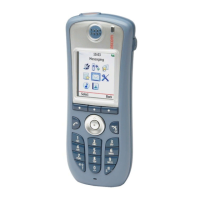TD 92685EN
28 June 2012 / Ver. A
Troubleshooting Guide
Ascom i62 VoWiFi Handset
14
3. The VoWiFi Handset as
The WLAN settings that are default are those for “Network A”, which uses the 2.4 GHz band
with the default channels 1.6 and 11.
Note: The handset will not change from 2.4 GHz channels to 5 GHz channels during t
he
probing session, unless the handset has been configured to automatically switch between
available networks. This capability is managed by setting the Auto-switch network
parameter in the PDM as described in the Configuration Manual, Ascom i62 VoWiFi Handset,
Handset Configuration chapter.
The correct channel set up in a WLAN is quite important. The
channels set up to be used by
the handset on any of the 2.4 GHz or 5GHz has impact on the performance of the handset.
To be able to detect APs when in passive scanning m
ode the handset must listen to each
channel slightly longer than the beacon interval, to be sure not to miss any beacon. The
handset then has to switch the radio channel and starts to listen again on the new channel.
By default the channels used in an
y scanning process, including site survey, is for the 2.4
GHZ band channel 1.6.11 and for the 5 GHz radio all channels for the domain.
Tip: Fo
r performance reasons when scanning, the amount of channels should be minimized
and only include the channels that are used in the WLAN.
Active scanning of the 5 GHz UNII-2 and UNII-2e
, the DFS-channels are not permitted in the
802.11 standard, so those channels will only be scanned in passive mode.
Note: The ha
ndset can use the DFS channels, but the Voice quality may be distorted. For
additional information, see section 3.7 DFS Channel Probing on
page 19.
3.5 Power Management
3.5.1 Overview
Power Save Battery conservation is supported
through the use of the WMM standard Power
Save mode (PS-mode) operation. The operation differs when the handset is idle or in call.
Idle
When the VoWiFi Handset is idle, it is in PS-mode and list
ens for broadcasts, multicasts and
unicasts at a beacon interval, which is configurable at the AP.
Call
When in call, one of two different modes are used de
pending on how the handset has been
configured and what functions are supported by the WLAN infrastructure:
• The handset parameter Voice p
ower save mode is set to "none". The handset stays
active during the call, only signaling PS-mode when scanning different channels in case
of roaming. When the call is ended, it returns to idle (PS-mode).
• The handset parameter Voice p
ower save mode is set to "U-APSD". In U-APSD the
handset is in PS-mode also during the call. The U-APSD functionality is negotiated with
the AP during association and provides the automatic release of buffered packets
immediately after an uplink packet. U-APSD maximizes battery lifetime and
performance. U-APSD must be supported by the WLAN infrastructure for a handset to be
able to use it.
Beacons
A beacon is broadcast from an AP to all handsets in the
BSS at a predefined beacon interval,
which is normally 100 Time Units (TUs) of 1.024ms or 102.4ms. A handset wakes up at
intervals determined by a Delivery Traffic Indication Message (DTIM) period, which is an

